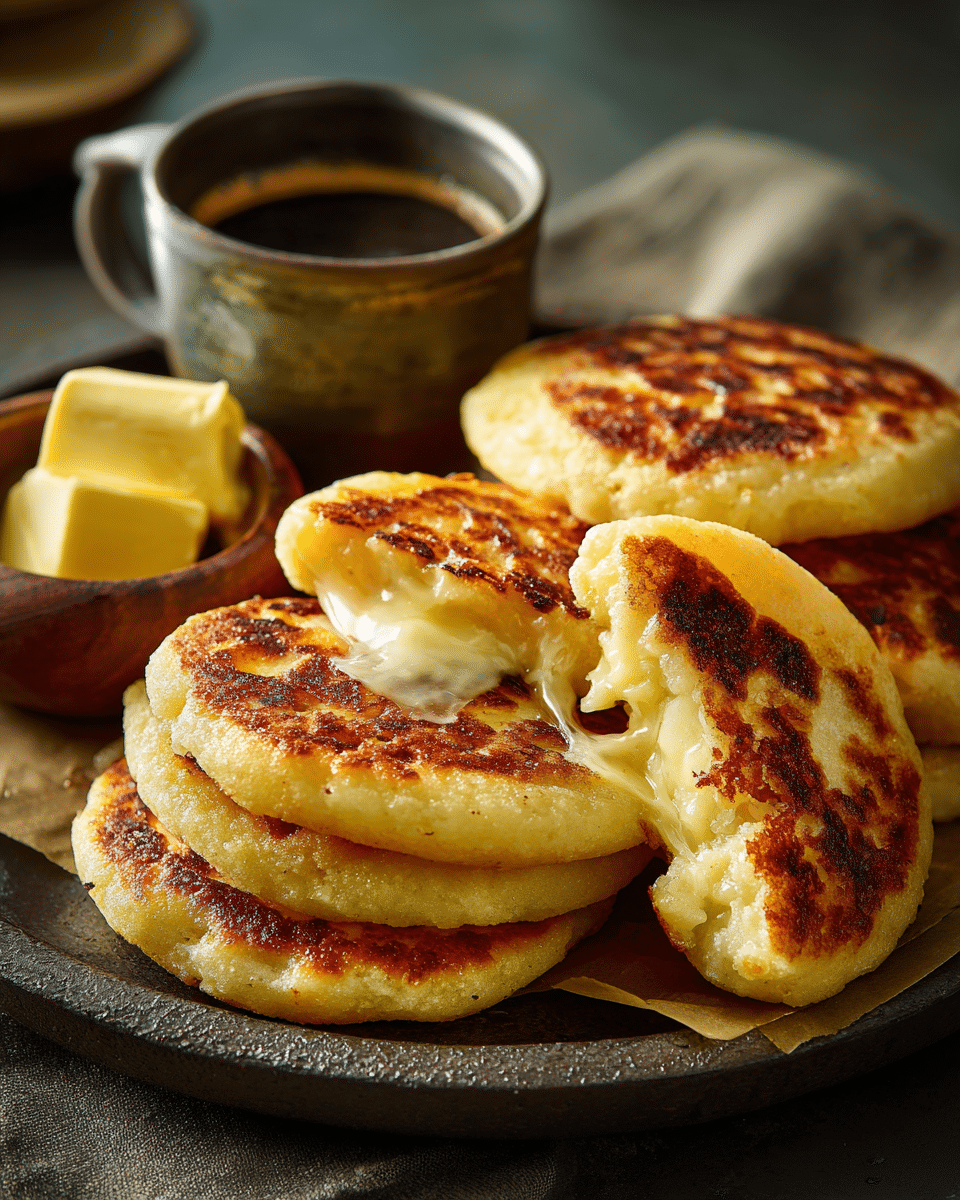Arepas con Queso are a classic Latin American comfort food, especially popular in Venezuela and Colombia. These golden, griddled corn cakes are crispy on the outside and soft inside, stuffed or topped with gooey melted cheese. Made from simple ingredients like pre-cooked cornmeal and cheese, they deliver warm, satisfying flavors perfect for breakfast, snacks, or even a light meal.
FULL RECIPE
Ingredients
- 2 cups pre-cooked white or yellow cornmeal (masarepa or harina PAN)
- 2 1/2 cups warm water
- 1 tsp salt
- 1 cup shredded mozzarella cheese (or queso fresco)
- 2 tbsp butter or vegetable oil (for cooking)
Directions
- In a large bowl, combine the warm water and salt. Gradually add the cornmeal, mixing with your hands or a spoon to avoid lumps.
- Knead the dough for about 3–5 minutes until smooth and pliable. Let it rest for 5 minutes.
- Divide the dough into 8 equal portions and shape each into a ball. Flatten each ball gently into a patty about 1/2 inch thick.
- Fold shredded cheese into half of the patties to make stuffed arepas, or reserve the cheese for topping later.
- Heat a large skillet or griddle over medium heat and add 1 tbsp of butter or oil.
- Place the arepas on the skillet and cook for about 5–6 minutes on each side until golden brown and crispy.
- If using cheese as topping, add shredded cheese on top of each arepa during the last minute of cooking and cover the skillet to melt the cheese.
- Remove from heat and serve warm, optionally slicing open and filling with more cheese or other fillings like avocado or ham.
Nutrition Facts
- Calories: 190
- Protein: 7g
- Total Fat: 7g
- Saturated Fat: 3.5g
- Cholesterol: 15mg
- Carbohydrates: 25g
- Dietary Fiber: 3g
- Sugars: 1g
- Sodium: 320mg
Historical Background of Arepas con Queso
Arepas have been a staple food in Latin America for centuries, especially in regions such as Venezuela and Colombia where corn has been a primary crop since pre-Columbian times. The simple corn dough, known as masa, was originally prepared by indigenous peoples, and over time, the addition of cheese became popular to enhance flavor and nutrition. Arepas con Queso evolved as a beloved comfort food, enjoyed at any time of day, reflecting a rich culinary heritage deeply rooted in Latin American culture and tradition.
The Importance of Pre-Cooked Cornmeal
A key component in making authentic arepas is the use of pre-cooked cornmeal, often labeled as masarepa or harina PAN. This specially treated corn flour absorbs water easily and forms a dough that’s both pliable and cohesive. Using pre-cooked cornmeal ensures the arepas have the right texture—crispy on the outside but tender and slightly chewy inside. This type of cornmeal is widely available in Latin American markets and has become popular worldwide due to its convenience.
Cheese Varieties and Their Impact on Flavor
While mozzarella cheese is a common choice for arepas con queso because of its excellent melting properties and mild flavor, regional cheeses like queso fresco, queso blanco, or even farmer’s cheese can be used. Each cheese brings its own unique texture and flavor profile, from the creamy and slightly tangy to the crumbly and salty. Selecting the right cheese influences the gooeyness and taste of the final dish, making cheese a central ingredient that personalizes each batch of arepas.
Cooking Techniques for the Perfect Arepa
Griddling arepas over medium heat is the traditional cooking method that delivers a satisfying crispy crust while maintaining a soft interior. Some cooks add a bit of butter or oil to the pan for additional flavor and golden color. The arepas are flipped carefully to ensure even cooking without breaking apart. Alternative cooking methods include baking or frying, each producing a different texture and flavor profile but the classic griddled method remains the most popular for a balanced, authentic result.
Health Benefits of Arepas con Queso
Arepas made with cornmeal are naturally gluten-free, making them suitable for people with gluten sensitivities or celiac disease. Corn is a good source of fiber, vitamins, and minerals like magnesium and phosphorus. When combined with cheese, the arepas provide a balanced mix of carbohydrates, protein, and fat. Moderation is key, however, as cheese can add saturated fats and sodium. Choosing lower-fat cheese options or controlling portion sizes can make this dish part of a nutritious diet.
Popular Variations and Fillings
While the classic arepa con queso features cheese either folded inside or melted on top, many variations exist to suit different tastes. Some popular fillings include shredded beef, black beans, avocado, eggs, or even sweet options like guava paste. In Venezuela and Colombia, street vendors and home cooks alike experiment with combinations that turn arepas into versatile meals ranging from breakfast to dinner, showcasing the adaptability of this humble corn cake.
Serving Suggestions and Pairings
Arepas con queso are often served as a standalone snack or breakfast, but they can be paired with a variety of sides to round out a meal. Traditional accompaniments include fried plantains, fresh avocado slices, or a light salad with tomatoes and onions. They also pair well with Latin American hot sauces and salsas that add a spicy or tangy kick. For drinks, fresh fruit juices or coffee complement the mild, comforting flavors of arepas perfectly.
Storage Tips for Arepas
Arepas are best enjoyed fresh off the griddle, but leftovers can be stored for later. To keep them fresh, wrap cooled arepas in plastic wrap or place them in an airtight container and refrigerate for up to 2–3 days. To reheat, gently toast them on a skillet or oven to restore their crispy crust. Freezing is also an option; simply freeze shaped but uncooked arepas on a tray before transferring them to a freezer bag. Thaw and cook directly from frozen for convenience.
Arepas con Queso for Special Diets
This recipe naturally fits gluten-free diets, but it can be adapted for other dietary preferences as well. For a lower-fat option, reduced-fat cheeses or smaller amounts of cheese can be used. Vegans can substitute cheese with plant-based alternatives or nutritional yeast to mimic the cheesy flavor. Additionally, incorporating vegetables like spinach or corn kernels into the dough adds nutritional value and variety, making arepas a versatile base for creative and health-conscious meals.
Advertisement
Cultural Significance and Modern Popularity
Arepas have transcended their traditional origins to become a beloved dish worldwide. Their simplicity and comforting taste have led to a growing international fan base, with restaurants and food trucks dedicated solely to serving arepas in diverse variations. They represent not only culinary heritage but also a symbol of home and family in Latin American communities abroad, making them an accessible and cherished taste of Latin culture wherever they are enjoyed.
Conclusion
Arepas con Queso offer more than just a satisfying meal—they embody centuries of tradition, cultural pride, and culinary creativity. Their simple ingredients combine to create a dish that is both comforting and versatile, appealing to a wide range of tastes and dietary needs. Whether enjoyed as a quick breakfast, a snack, or part of a larger meal, these cheesy corn cakes continue to warm hearts and palates, making them a timeless favorite in Latin American cuisine and beyond.






